Anti-Agglomeration Behavior and Sensing Assay of Chlorsulfuron Based on Acetamiprid-Gold Nanoparticles
Abstract
1. Introduction
2. Materials and Methods
2.1. Chemicals and Apparatus
2.2. Synthesis of AuNPs
2.3. Colorimetric Assay
2.4. Sample Pretreatment
3. Results and Discussion
3.1. Characterization
3.2. Colorimetric Sensing Mechanism
3.3. Optimization of the Method
3.3.1. Effect of the Acetamiprid Concentration
3.3.2. Effect of pH
3.4. Colorimetric Sensing of Chlorsulfuron
3.5. Selectivity
3.6. Application to Agricultural Irrigation Water Samples
4. Conclusions
Author Contributions
Funding
Conflicts of Interest
References
- Cara, I.-G.; Rusu, B.-G.; Raus, L.; Jitareanu, G. Sorption potential of alkaline treated straw and a soil for sulfonylurea herbicide removal from aqueous solutions: An environmental management strategy. Chemosphere 2017, 186, 360–366. [Google Scholar] [CrossRef] [PubMed]
- Souza, F.L.; Sáez, C.; Lanza, M.R.V.; Cañizares, P.; Rodrigo, M.A. Removal of chlorsulfuron and 2,4-D from spiked soil using reversible electrokinetic adsorption barriers. Purif. Technol. 2017, 178, 147–153. [Google Scholar] [CrossRef]
- Alesso, M.; Escudero, L.A.; Talio, M.C.; Fernández, L.P. Monitoring of chlorsulfuron in biological fluids and water samples by molecular fluorescence using rhodamine B as fluorophore. Talanta 2016, 160, 431–436. [Google Scholar] [CrossRef] [PubMed]
- Berrada, H.; Font, G.; Moltó, J.C. Influence of the solvent on the gas chromatographic behaviour of urea herbicides. Chromatographia 2001, 54, 253–262. [Google Scholar] [CrossRef]
- Kiljanek, T.; Niewiadowska, A.; Semeniuk, S.; Gaweł, M.; Borzęcka, M.; Posyniak, A. Multi-residue method for the determination of pesticides and pesticide metabolites in honeybees by liquid and gas chromatography coupled with tandem mass spectrometry-Honeybee poisoning incidents. J. Chromatogr. A 2016, 1435, 100–114. [Google Scholar] [CrossRef] [PubMed]
- Tadeo, J.L.; Sánchez-Brunete, C.; Pérez, R.A.; Fernández, M.D. Analysis of herbicide residues in cereals, fruits and vegetables. J. Chromatogr. A 2000, 882, 175–191. [Google Scholar] [CrossRef]
- Bernal, J.L.; Jime´nez, J.J.; Atienza, J. Determination of chlorsulfuron and tribenuron-methyl residues in agricultural soils. J. Chromatogr. A 1997, 778, 119–125. [Google Scholar] [CrossRef]
- Yan, C.; Zhang, B.; Liu, W.; Feng, F.; Zhao, Y.; Du, H. Rapid determination of sixteen sulfonylurea herbicides in surface water by solid phase extraction cleanup and ultra-high-pressure liquid chromatography coupled with tandem mass spectrometry. J. Chromatogr. B 2011, 879, 3484–3489. [Google Scholar] [CrossRef] [PubMed]
- Eremin, S.A.; Ryabova, I.A.; Yakovleva, J.N.; Yazynina, E.V.; Zherdev, A.V.; Dzantiev, B.B. Development of a rapid, specific fluorescence polarization immunoassay for the herbicide chlorsulfuron. Anal. Chim. Acta 2002, 468, 229–236. [Google Scholar] [CrossRef]
- Springer, V.H.; Lista, A.G. A simple and fast method for chlorsulfuron and metsulfuron methyl determination in water samples using multiwalled carbon nanotubes (MWCNTs) and capillary electrophoresis. Talanta 2010, 83, 126–129. [Google Scholar] [CrossRef] [PubMed]
- Nangia, Y.; Bhalla, V.; Kumar, B.; Suri, C.R. Electrochemical stripping voltammetry of gold ions for development of ultra-sensitive immunoassay for chlorsulfuron. Electrochem. Commun. 2012, 14, 51–54. [Google Scholar] [CrossRef]
- Coly, A.; Aaron, J.-J. Sensitive and rapid flow injection analysis of sulfonylurea herbicides in water with micellar-enhanced photochemically induced fluorescence detection. Anal. Chim. Acta 1999, 392, 255–264. [Google Scholar] [CrossRef]
- Ma, J.; Jiang, L.; Wu, G.; Xia, Y.; Lu, W.; Li, J.; Chen, L. Determination of six sulfonylurea herbicides in environmental water samples by magnetic solid-phase extraction using multi-walled carbon nanotubes as adsorbents coupled with high-performance liquid chromatography. J. Chromatogr. A 2016, 1466, 12–20. [Google Scholar] [CrossRef] [PubMed]
- Fusco, G.; Gallo, F.; Tortolini, C.; Bollella, P.; Ietto, F.; De Mico, A.; D’Annibale, S.; Antiochia, R.; Favero, G.; Mazzei, F. AuNPs-functionalized PANABA-MWCNTs nanocomposite-based impedimetric immunosensor for 2,4-dichlorophenoxy acetic acid detection. Biosens. Bioelectron. 2017, 93, 52–56. [Google Scholar] [CrossRef] [PubMed]
- Tan, L.; Chen, Z.; Zhang, C.; Wei, X.; Lou, T.; Zhao, Y. Colorimetric Detection of Hg2+ Based on the Growth of Aptamer-Coated AuNPs: The Effect of Prolonging Aptamer Strands. Small 2017, 13, 1603370. [Google Scholar] [CrossRef] [PubMed]
- Chen, N.; Liu, H.; Zhang, Y.; Zhou, Z.; Fan, W.; Yu, G.; Shen, Z.; Wu, A. A colorimetric sensor based on citrate-stabilized AuNPs for rapid pesticide residue detection of terbuthylazine and dimethoate. Sens. Actuat. B 2018, 255, 3093–3101. [Google Scholar] [CrossRef]
- Lu, S.; Wang, S.; Chen, C.; Sun, J.; Yang, X. Enzyme-free aptamer/AuNPs-based fluorometric and colorimetric dual-mode detection for ATP. Sens. Actuat. B 2018, 265, 67–74. [Google Scholar] [CrossRef]
- Dong, H.; Zou, F.; Li, H.; Zhu, H.; Koh, K.; Yin, Y.; Chen, H. Thionine mediated para-sulfonatocalix[4]arene capped AuNPs multilayers for sensitive electrochemical detection of acetylcholinesterase activity. Electrochim. Acta 2018, 267, 206–212. [Google Scholar] [CrossRef]
- Liu, G.; Wang, S.; Yang, X.; Li, T.; She, Y.; Wang, J.; Zou, P.; Jin, F.; Jin, M.; Shao, H. Colorimetric sensing of atrazine in rice samples using cysteamine functionalized gold nanoparticles after solid phase extraction. Anal. Methods 2016, 8, 52–56. [Google Scholar] [CrossRef]
- Liu, G.; Yang, X.; Li, T.; Yu, H.; Du, X.; She, Y.; Wang, J.; Wang, S.; Jin, F.; Jin, M.; et al. Spectrophotometric and visual detection of the herbicide atrazine by exploiting hydrogen bond-induced aggregation of melamine-modified gold nanoparticles. Microchim. Acta 2015, 182, 1983–1989. [Google Scholar] [CrossRef]
- Liu, G.; Huang, X.; Zheng, S.; Li, L.; Xu, D.; Xu, X.; Zhang, Y.; Lin, H. Novel triadimenol detection assay based on fluorescence resonance energy transfer between gold nanoparticles and cadmium telluride quantum dots. Dyes Pigments 2018, 149, 229–235. [Google Scholar] [CrossRef]
- Zhang, X.; Sun, Z.; Cui, Z.; Li, H. Ionic liquid functionalized gold nanoparticles: Synthesis, rapid colorimetric detection of imidacloprid. Sens. Actuat. B 2014, 191, 313–319. [Google Scholar] [CrossRef]
- Mehta, V.N.; Basu, H.; Singhal, R.K.; Kailasa, S.K. Simple and sensitive colorimetric sensing of Cd2+ ion using chitosan dithiocarbamate functionalized gold nanoparticles as a probe. Sens. Actuat. B 2015, 220, 850–858. [Google Scholar] [CrossRef]
- Zhou, Z.; Zhang, Y.; Kang, J.; Dong, C.; Chen, N.; Li, X.; Guo, Z.; Wu, A. Detection of herbicide glyphosates based on an anti-aggregation mechanism by using unmodified gold nanoparticles in the presence of Pb2+. Anal. Methods 2017, 9, 2890–2896. [Google Scholar] [CrossRef]
- Sun, X.; Liu, R.; Liu, Q.; Fei, Q.; Feng, G.; Shan, H.; Huan, Y. Colorimetric sensing of mercury (II) ion based on anti-aggregation of gold nanoparticles in the presence of hexadecyl trimethyl ammonium bromide. Sens. Actuat. B 2018, 260, 998–1003. [Google Scholar] [CrossRef]
- Safavi, A.; Ahmadi, R.; Mohammadpour, Z. Colorimetric sensing of silver ion based on anti aggregation of gold nanoparticles. Sens. Actuat. B 2017, 242, 609–615. [Google Scholar] [CrossRef]
- Liu, G.; Zhang, R.; Huang, X.; Li, L.; Liu, N.; Wang, J.; Xu, D. Visual and colorimetric sensing of metsulfuron-methyl by exploiting hydrogen bond-induced anti-aggregation of gold nanoparticles in the presence of melamine. Sensors 2018, 18, 1595. [Google Scholar] [CrossRef] [PubMed]
- Godoy-Reyes, T.M.; Llopis-Lorente, A.; Costero, A.M.; Sancenón, F.; Gaviña, P.; Martínez-Máñez, R. Selective and sensitive colorimetric detection of the neurotransmitter serotonin based on the aggregation of bifunctionalised gold nanoparticles. Sens. Actuat. B 2018, 258, 829–835. [Google Scholar] [CrossRef]
- Feng, B.; Zhu, R.; Xu, S.; Chen, Y.; Di, J. A sensitive LSPR sensor based on glutathione-functionalized gold nanoparticles on a substrate for the detection of Pb2+ ions. RSC Adv. 2018, 8, 4049–4056. [Google Scholar] [CrossRef]
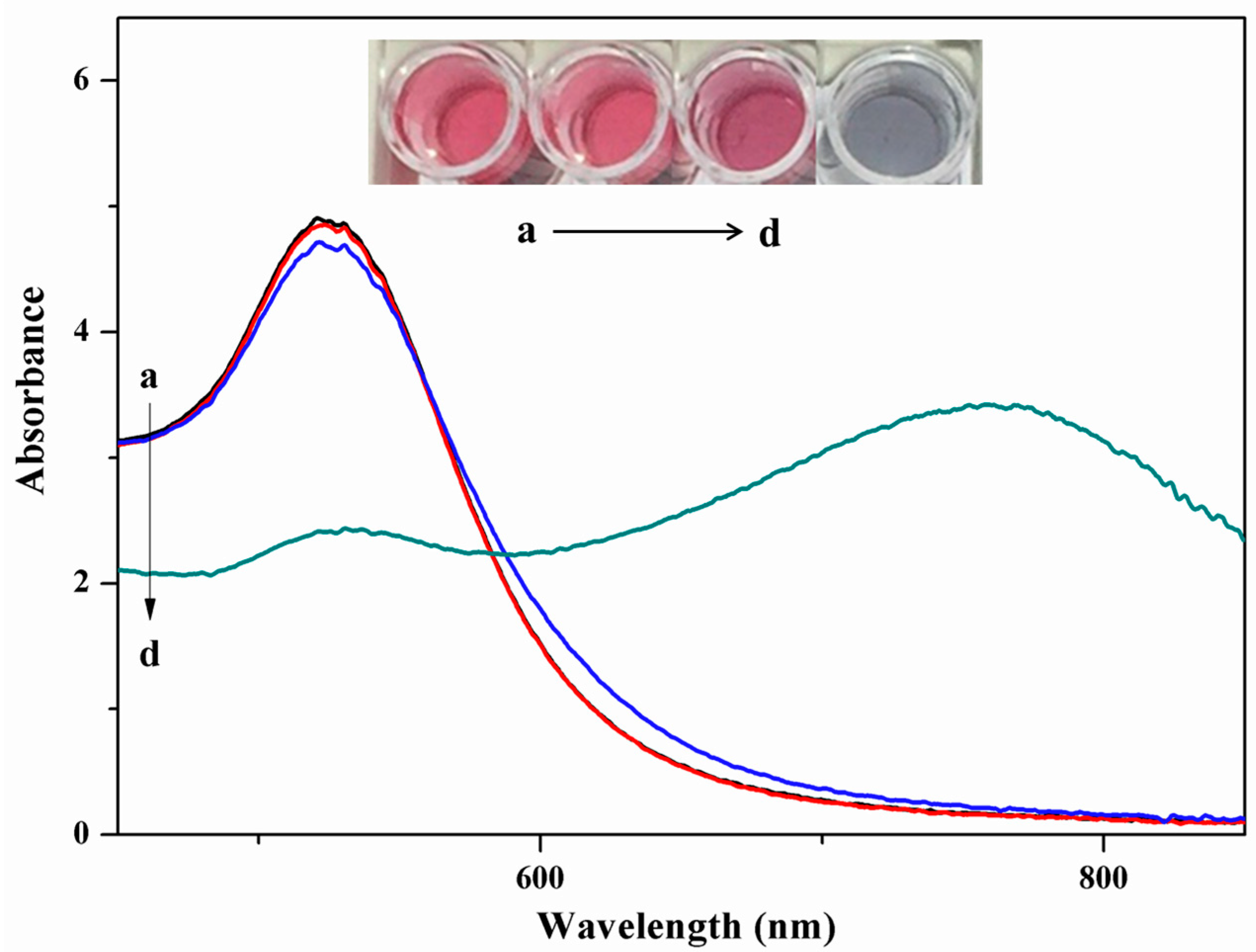
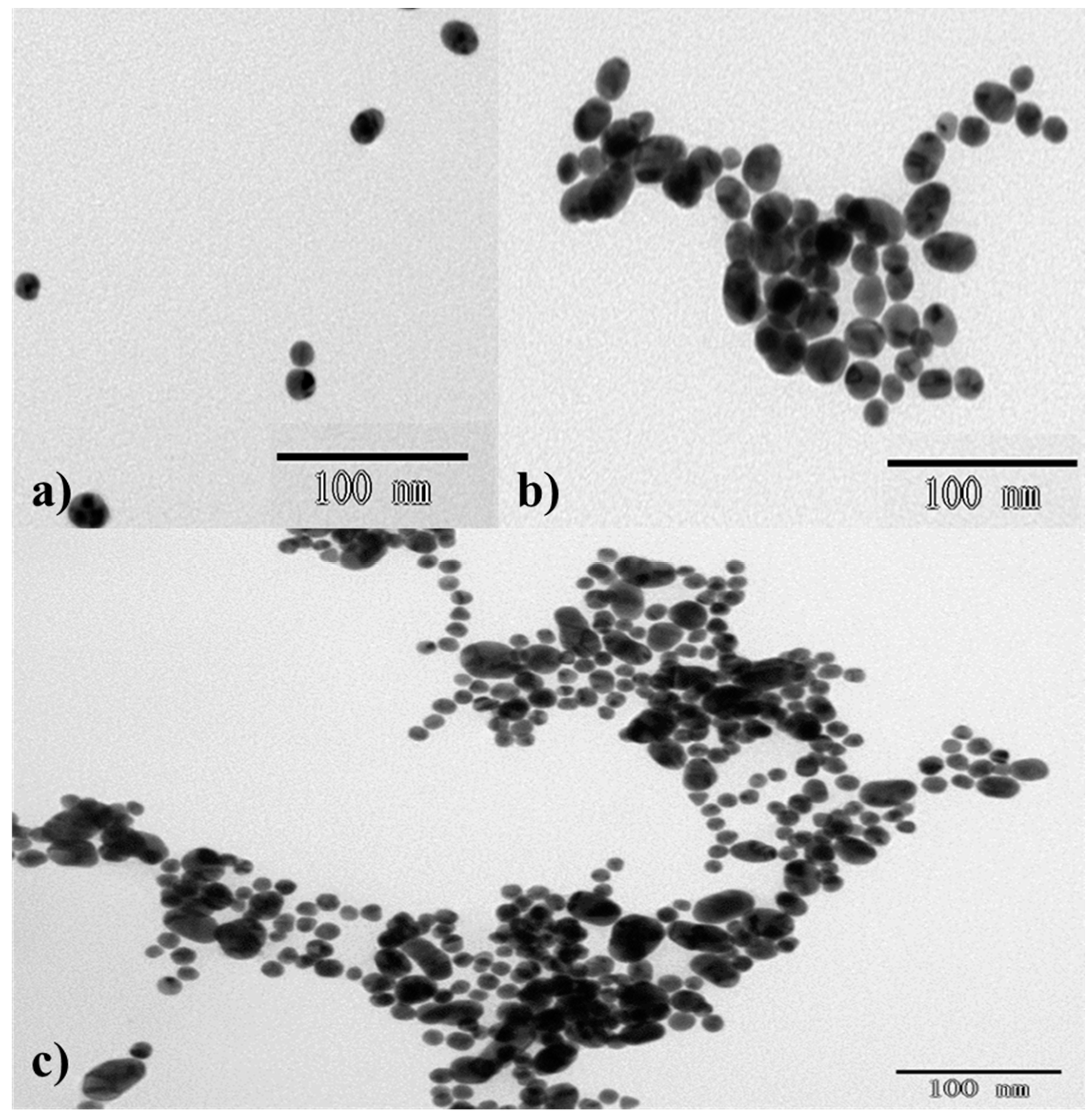

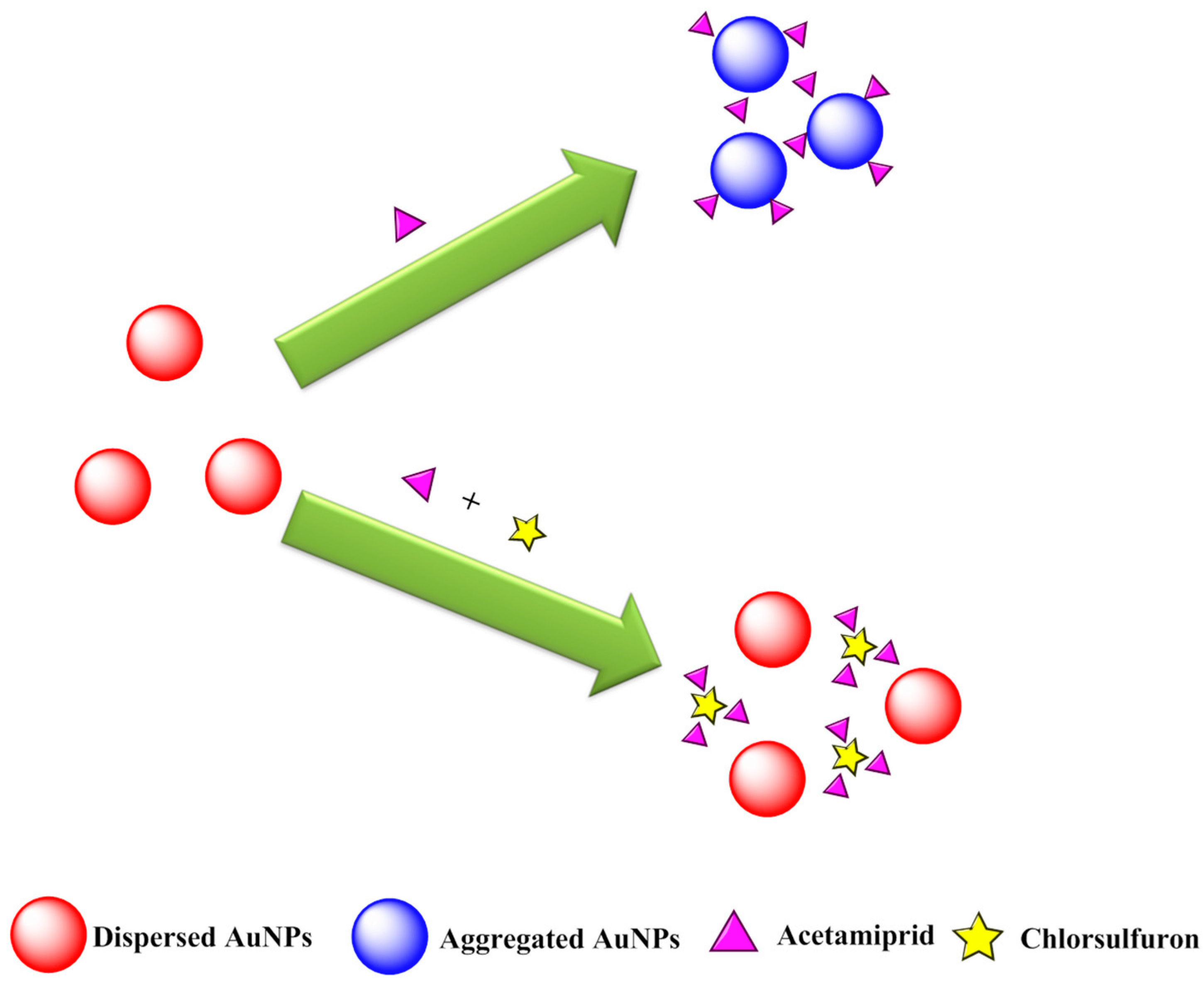
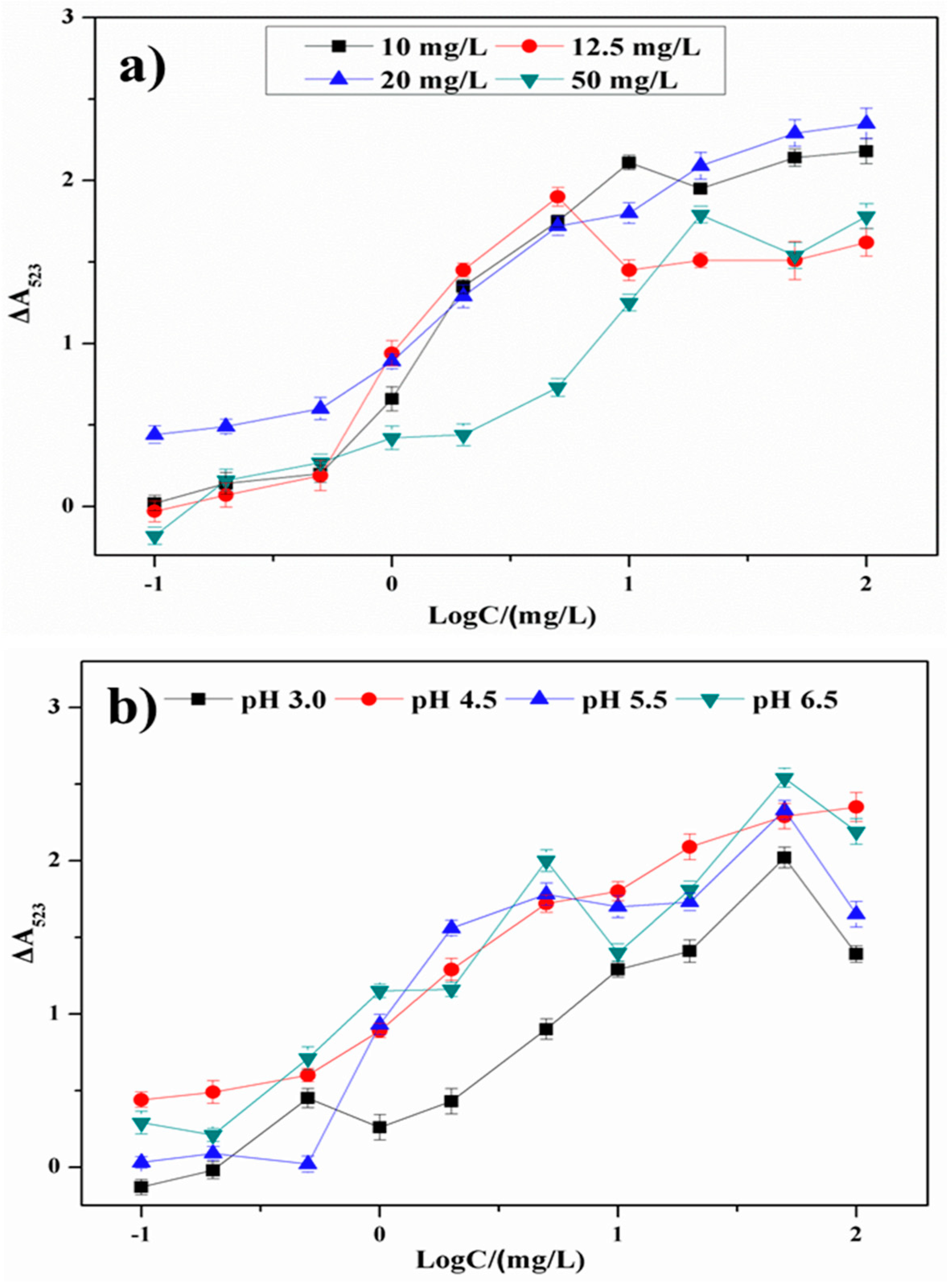
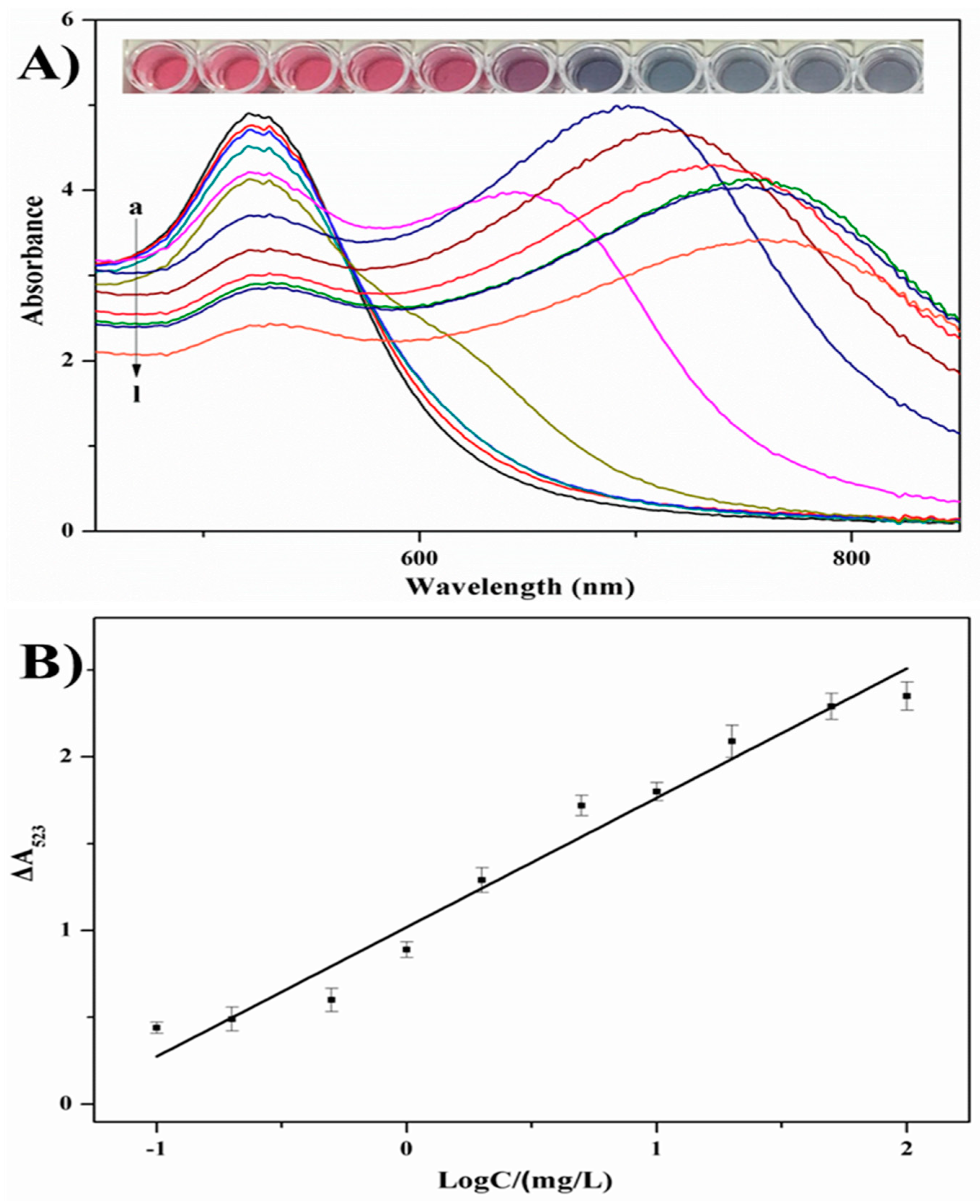
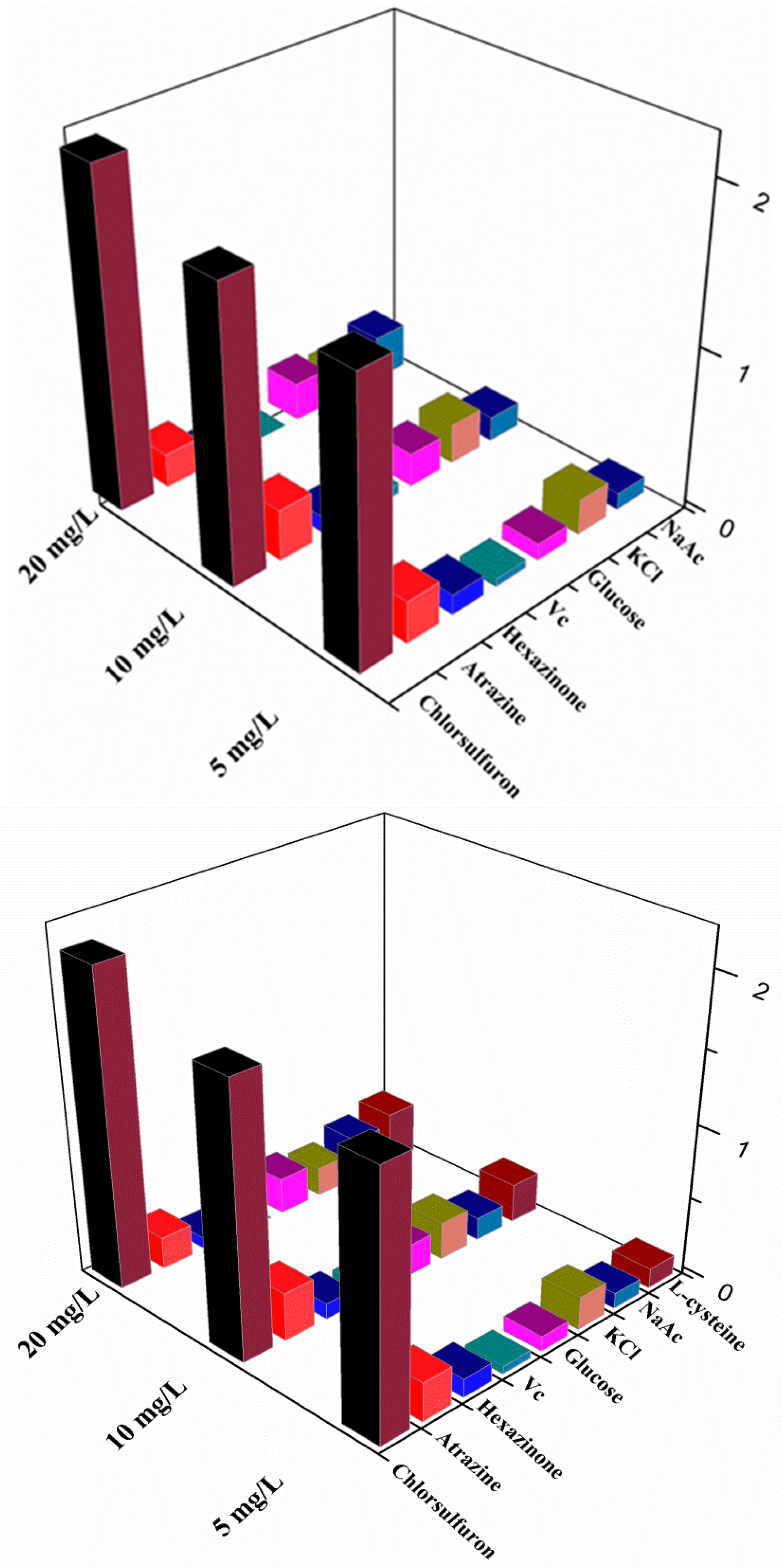
| Methods | Linear Range (mg/L) | LOD (mg/L) | R2 | Matrices | Reference |
|---|---|---|---|---|---|
| HPLC-CAD | 0.01–1.0 | 0.01–0.05 | 0.999 | Grain, straw, green plant | [6] |
| HPLC-UV | 0.02–5 | 0.08 | 0.999 | Soil | [7] |
| Fluorescence detection | 0.01–1.0 | 0.01 | 0.999 | Environmental water | [9] |
| Electrochemical Immunoassay | - | 0.005 | - | Environmental water | [11] |
| Anti-aggregation-AuNPs based UV–Vis detection | 0.1–100 | 0.05 | 0.957 | Irrigation water | This work |
| Samples | Spiked (mg/L) | Found (mg/L) | Recovery (%) | RSD (%) | LOD (mg/L) |
|---|---|---|---|---|---|
| Tap water | 0 | - | - | - | 0.125 |
| 0.5 | 0.421 | 84.1 | 4.25 | ||
| 1.0 | 0.817 | 81.7 | 3.62 | ||
| 5.0 | 4.52 | 90.4 | 6.47 | ||
| Well water | 0 | - | - | - | 0.25 |
| 0.5 | 0.382 | 76.3 | 7.34 | ||
| 1.0 | 0.785 | 78.5 | 4.19 | ||
| 5.0 | 4.71 | 94.2 | 5.62 |
© 2018 by the authors. Licensee MDPI, Basel, Switzerland. This article is an open access article distributed under the terms and conditions of the Creative Commons Attribution (CC BY) license (http://creativecommons.org/licenses/by/4.0/).
Share and Cite
Liu, G.; Zhang, R.; Li, L.; Huang, X.; Li, T.; Lu, M.; Xu, D.; Wang, J. Anti-Agglomeration Behavior and Sensing Assay of Chlorsulfuron Based on Acetamiprid-Gold Nanoparticles. Nanomaterials 2018, 8, 499. https://doi.org/10.3390/nano8070499
Liu G, Zhang R, Li L, Huang X, Li T, Lu M, Xu D, Wang J. Anti-Agglomeration Behavior and Sensing Assay of Chlorsulfuron Based on Acetamiprid-Gold Nanoparticles. Nanomaterials. 2018; 8(7):499. https://doi.org/10.3390/nano8070499
Chicago/Turabian StyleLiu, Guangyang, Ruonan Zhang, Lingyun Li, Xiaodong Huang, Tengfei Li, Meng Lu, Donghui Xu, and Jing Wang. 2018. "Anti-Agglomeration Behavior and Sensing Assay of Chlorsulfuron Based on Acetamiprid-Gold Nanoparticles" Nanomaterials 8, no. 7: 499. https://doi.org/10.3390/nano8070499
APA StyleLiu, G., Zhang, R., Li, L., Huang, X., Li, T., Lu, M., Xu, D., & Wang, J. (2018). Anti-Agglomeration Behavior and Sensing Assay of Chlorsulfuron Based on Acetamiprid-Gold Nanoparticles. Nanomaterials, 8(7), 499. https://doi.org/10.3390/nano8070499






